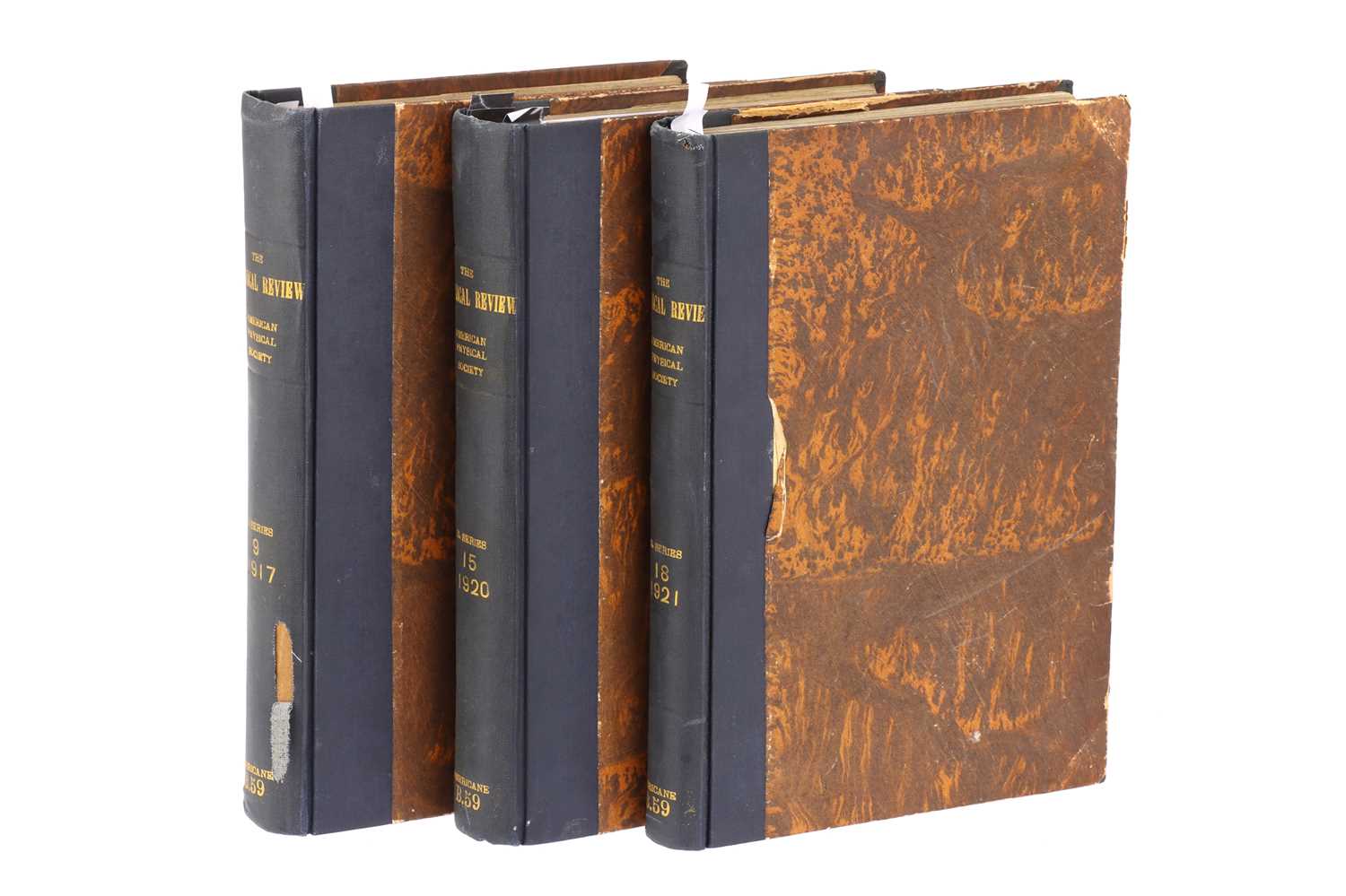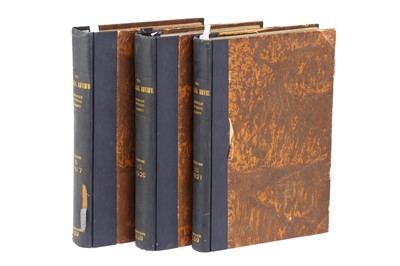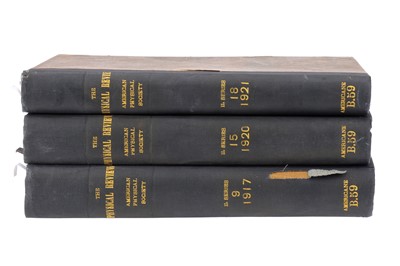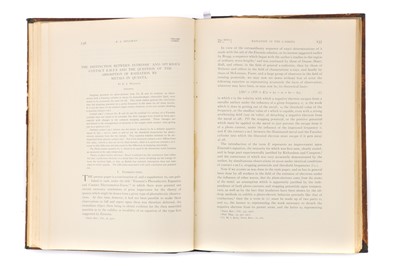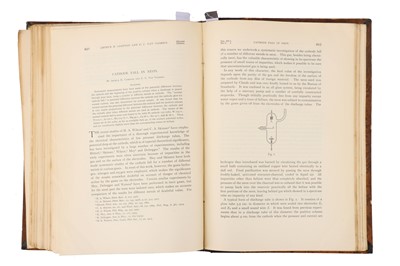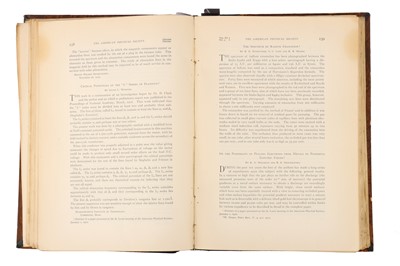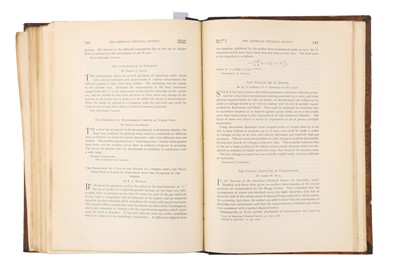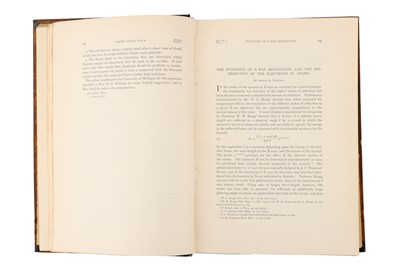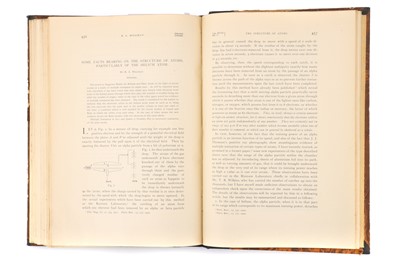24th May, 2023 12:00
Fine Instruments of Science, Medicine and Books
Millikan R. A. Printed Journals & Articles
hello
1 - The Physical Review A Journal of Experimental Physics, Second Series, May 1917 vol.IX no.5, bound journal, with some end papers, R. A. Millikan’s paper ’Theoretical considerations relating to the single lined and the many lined spectrum of mercury’, [p.378 – p.382], and Arthur H. Compton’s paper ’ The intensity of X-ray reflection, and the distribution of the electrons in atoms’, [p.29 – p.57]
2 - The Physical Review A Journal of Experimental Physics, Second Series, March 1920, vol.XV no.3, bound journal, R. A. Millikan and B. E. Schackelford’s paper ’The possibility of pulling electrons from metals by powerful electric fields’. [p.239 – p.240], and R A. Millikans paper ’The resistance of a gas to the motion of a sphere when the mean free path is large in comparison with the diameter of the sphere’, [Pp 544], and, R. A. Millikan, V. H. Gottschalk and M. J.. Kelly’s paper ’The Nature of the Process of Ionization of Gasses by Alpha Rays [p157 – p.177], and Arthur H. Compton and C. C. Van Voorhis’ paper ’ Cathode fall in neon’, [p.492 – p. 497]
3 - The Physical Review A Journal of Experimental Physics, Second Series, September 1921, vol.XVIII no.3, bound journal, with some end papers, R. A. Millikan’s paper ’The distinction between intrinsic and spurious contact EMFS and the question of the absorption of radiation by metals in quanta’, [p.136 – p.244]
Robert Andrews Millikan was an American experimental physicist born in 1868. He was known for his work in measuring the elementary electric charge and his contributions to the study of the photoelectric effect. Millikan was awarded the Nobel Prize for Physics in 1923 for his groundbreaking work in these areas.
Millikan's most famous experiment involved suspending tiny oil droplets in an electric field and measuring their motion. By measuring the electric charge on the droplets and the strength of the electric field, Millikan was able to determine the charge of a single electron. This was a crucial step in understanding the nature of electricity and paved the way for future research in the field.
In addition to his work on the electric charge of electrons, Millikan also made important contributions to the study of the photoelectric effect. This phenomenon occurs when electrons are emitted from a material exposed to light. Millikan's research helped to establish the fundamental principles underlying this effect and was instrumental in the development of modern electronics.
Throughout his career, Millikan was known for his meticulous attention to detail and his commitment to scientific accuracy. His work laid the foundation for many of the advances in modern physics and continues to inspire scientists around the world to this day.
hello
1 - The Physical Review A Journal of Experimental Physics, Second Series, May 1917 vol.IX no.5, bound journal, with some end papers, R. A. Millikan’s paper ’Theoretical considerations relating to the single lined and the many lined spectrum of mercury’, [p.378 – p.382], and Arthur H. Compton’s paper ’ The intensity of X-ray reflection, and the distribution of the electrons in atoms’, [p.29 – p.57]
2 - The Physical Review A Journal of Experimental Physics, Second Series, March 1920, vol.XV no.3, bound journal, R. A. Millikan and B. E. Schackelford’s paper ’The possibility of pulling electrons from metals by powerful electric fields’. [p.239 – p.240], and R A. Millikans paper ’The resistance of a gas to the motion of a sphere when the mean free path is large in comparison with the diameter of the sphere’, [Pp 544], and, R. A. Millikan, V. H. Gottschalk and M. J.. Kelly’s paper ’The Nature of the Process of Ionization of Gasses by Alpha Rays [p157 – p.177], and Arthur H. Compton and C. C. Van Voorhis’ paper ’ Cathode fall in neon’, [p.492 – p. 497]
3 - The Physical Review A Journal of Experimental Physics, Second Series, September 1921, vol.XVIII no.3, bound journal, with some end papers, R. A. Millikan’s paper ’The distinction between intrinsic and spurious contact EMFS and the question of the absorption of radiation by metals in quanta’, [p.136 – p.244]
Robert Andrews Millikan was an American experimental physicist born in 1868. He was known for his work in measuring the elementary electric charge and his contributions to the study of the photoelectric effect. Millikan was awarded the Nobel Prize for Physics in 1923 for his groundbreaking work in these areas.
Millikan's most famous experiment involved suspending tiny oil droplets in an electric field and measuring their motion. By measuring the electric charge on the droplets and the strength of the electric field, Millikan was able to determine the charge of a single electron. This was a crucial step in understanding the nature of electricity and paved the way for future research in the field.
In addition to his work on the electric charge of electrons, Millikan also made important contributions to the study of the photoelectric effect. This phenomenon occurs when electrons are emitted from a material exposed to light. Millikan's research helped to establish the fundamental principles underlying this effect and was instrumental in the development of modern electronics.
Throughout his career, Millikan was known for his meticulous attention to detail and his commitment to scientific accuracy. His work laid the foundation for many of the advances in modern physics and continues to inspire scientists around the world to this day.
